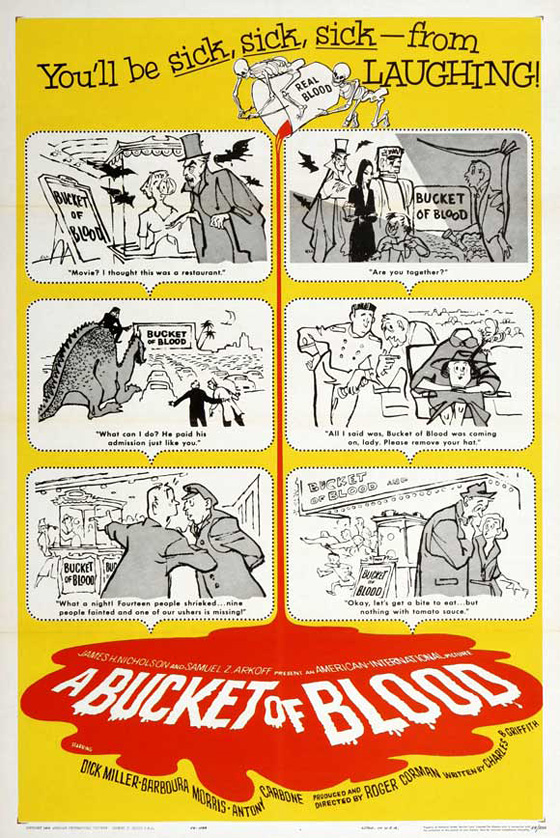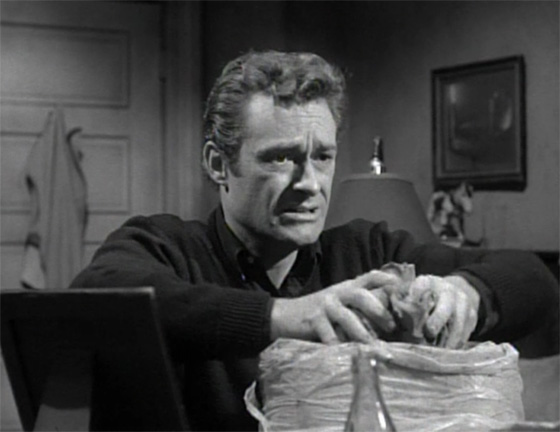
“Life is an obscure hobo bumming a ride on the omnibus of Art,” quoth the Beatnik while the saxophone plays and, incongruously, the title A Bucket of Blood flashes onto the screen. We’re in the hands of Roger Corman, just as he’s entered a new phase of his career, one abetted in no small part by screenwriter Charles B. Griffith. The two would form an electric bond: Corman, learning to shoot faster and cheaper while maximizing the impact of his cast and lean, mean narratives; and 29-year-old Griffith, who had been writing for Corman for a few years, now turning to satire and helping the producer/director explore the genre of black comedy. Corman has proposed A Bucket of Blood (1959) as the first of a trilogy, the others being The Little Shop of Horrors (1960) and Creature From the Haunted Sea (1961), each of them offering a parodic twist on the typical drive-in horror picture. And for the star to launch this new direction, Corman chose one of the most promising talents in his repertory company, Dick Miller, who had played a fast-talking vacuum cleaner salesman in Not of This Earth (1957) and the square-jawed hero in War of the Satellites (1958). Now he’d try something a little different: a pathetic milquetoast named Walter Paisley. His performance would become so iconic that the character name would be reused, as an in-joke and homage, for Dick Miller roles in Hollywood Boulevard (1976), The Howling (1981), Twilight Zone: The Movie (1982), Chopping Mall (1986), and Shake, Rattle & Rock! (1994).
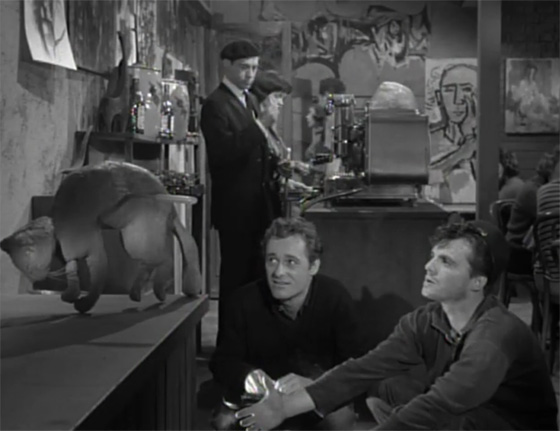
Walter Paisley (Dick Miller) showcases his debut as an artist: "Dead Cat."
Walter works at a beatnik dive, in awe of the artists who surround him, including the poet, Maxwell Brock (Julian Burton), who opens the film and virtually narrates with his pretentious verse. But timid Walter is the butt of the beatniks’ jokes, only earning sympathy from the lovely Carla (Barboura Morris, The Wasp Woman), with whom he’s secretly in love. One night, while trying to sculpt clay to prove himself to his peers, Walter realizes that his landlady’s cat has gotten itself stuck inside the wall. He tries to cut it free, but when he stabs the wall with a knife, he hears a feline shriek on the other side. Absorbed by grief, and suffering a nervous breakdown, something snaps within him. He covers the little corpse with clay. The next morning, he presents his work of art to Carla and the club owner, Leonard (Antony Carbone, The Last Woman on Earth): a cat statue with a knife sticking out of its side. Carla is immediately impressed by the apparent craftsmanship, though Leonard is afraid it will scare the clientele away. “What’s it called?” he asks, and Walter responds, in more of a question than an answer, “‘Dead Cat.'” Inspecting it closer, Leonard asks, “How come you put a knife into it?” “I didn’t mean to,” Walter responds, honestly. At Carla’s urging, Leonard at last relents to displaying the piece in the club. “Does this mean I’m an artist?” “Yeah, you’re a real artist now. Now go on back and scrub down those garbage cans.”
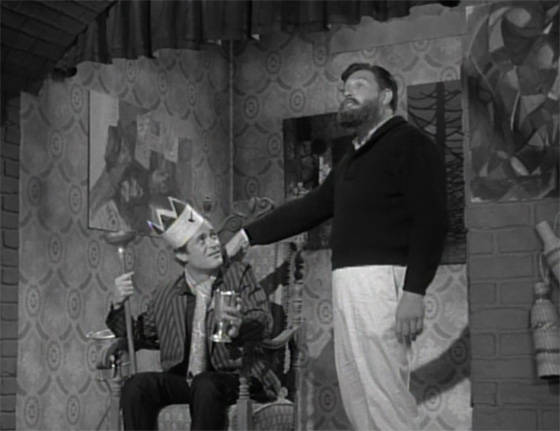
Walter is crowned by his new champion, the poet Maxwell Brock (Julian Burton).
No longer mocking, the beatniks are impressed by Walter’s debut as a sculptor. Maxwell Brock is particularly anxious to be known as the one who discovered this brilliant outsider artist. His delirious speech illustrates why screenwriter Griffith was the most important weapon in Corman’s arsenal. “Attention everyone! As you pass through these yellow portals I am sure you noticed on your right a small clay figure, and assumed this transfixed effigy to be the work of a master sculptor. And indeed, so it is…he is none other than Walter Paisley, our very own busboy, whose hands of genius have been carrying away the empty cups of your frustration. Mark well this lad. His is the silent voice of creation. Within the dark, rich soil of humility, he blossoms as the hope of our nearly sterile century! Bring me an espresso, Walter.” Leonard is so taken by Walter’s commercial potential that he asks him to make another cat. “But I haven’t got another cat,” Walter protests. Yet an opportunity presents itself when a cop comes knocking at his door, arresting Walter for the possession of heroin, which our hero had accepted in ignorance from a grateful patron. Panicked, Walter brings down a frying pan on the officer’s head, splitting his skull…and the next day he has a new sculpture to present to his audience: “Murdered Man.” They’re shocked by his astounding skill. It’s suggested that he gather enough works to put on a show; and Walter, thrilled at the attention – particularly from Carla – is open to the idea.
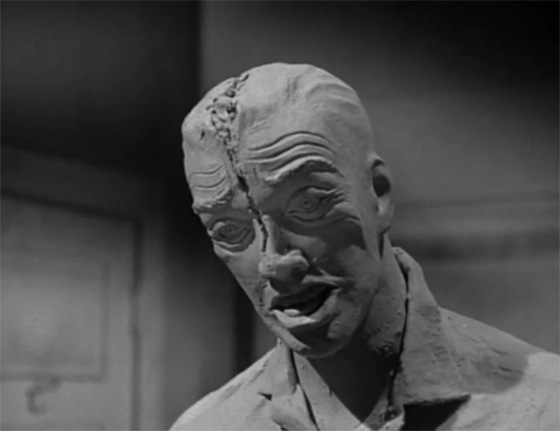
Walter's second creation, "Murdered Man."
At just 65 minutes, A Bucket of Blood has the feel of a classic E.C. Comics tale, wedding gore with subversive humor. Corman and Griffith had collaborated on the story, inspired as much by Mystery of the Wax Museum (1933) and House of Wax (1953) as by their research at beatnik joints along the Sunset Strip; clearly Griffith relished sending up the characters they encountered. You don’t expect to see this much wit on display in a 50’s B-movie; Corman writes in his autobiography How I Made a Hundred Movies in Hollywood and Never Lost a Dime that the sneak preview audience “laughed throughout the film and applauded at the end.” But art world satire aside (which anticipates 2010’s Exit Through the Gift Shop), it’s also a fascinating character study. At the opening of the film, Walter quotes Maxwell’s own poetry back to him in fanboy admiration; Maxwell scoffs that “repetition is death,” stressing the need for an artist to be original. He’s right. Walter is trapped in the wakes of others; throughout the film he’s repeating words spoken by his friends, and replaying dialogue in his head, forever haunted by put-downs and expectations. Giddy at being regarded as an artist, he truly doesn’t grasp the concept: his first response to Leonard’s appraisal of “Dead Cat” is “Do you wanna buy it?” He thinks he can sculpt (and murder) his way into Carla’s heart, and leaps to a marriage proposal without taking the step of a first date. When she explains that she admires his art, but doesn’t love him, the concept unravels poor Walter. Miller captures the tragically childlike quality of his character, and it’s no wonder that this is often called his greatest performance. (Given that Miller was seldom offered a lead role, the film is all the more valuable.) The film’s only weakness is its budget: American International Pictures could offer Corman just $50,000 for the shoot, and he made the picture over a breakneck five days. So when Carla marvels over the “detail” in “Dead Cat” and Walter’s other sculptures, the audience is required to suspend their disbelief. But A Bucket of Blood proves itself to be more inspired than anything from Walter Paisley’s workshop. It’s Corman at his best.
